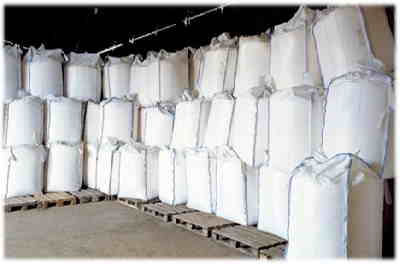Storage of powder material in bulk quantities such as big bags and the subsequent stacking of big bags often changes the powder flow properties of materials and induces a powder caking phenomenon: a free flowing material is transformed into a lumpy material with dramatically changed and quite often undesired flow behaviour. The origin of such powder caking can be related to physical or mechanical blockage. However, also more complex phenomena like solid phase transitions and particle deformation, either elastic or plastic deformation, can be an underlying mechanism. Variables such as particle size distribution, interaction of the surface with moisture and effect of time and temperature should be considered when studing the phenomenon of powder caking.
Uni-axial Compact Strength testing is a very suitable measurement methodology to study this caking phenomenon of powder or granular materials and detect changes in powder flow behaviour due to compaction and confinement. These studies can be carried out over a wide range of consolidation pressures, for a different duration, and under a variety of temperature and relative humidity conditions. In such powder caking study the material under investigation is exposed to certain consolidation conditions and afterwards the failure strength, i.e. the force to break up the formed unconfined powder cake, is being determined. In this way, critical conditions for (preventing) caking to occur can be identified and this information can be used to change the product formulation, the unit operation, or the storage conditions. This should then lead to an improved product quality since the product displays a more reliable powder flow behaviour and powder caking is not taking place.
The uni-axial compact strength measurement methodolgy is also suitable to investigate the role of anti-caking agents or flowing agents on the powder products being studied. Anti-caking agents or flowing agents are added to many powdered products to minimize the powder caking phenomenon and keep the powder flowing. The use of the uni-axial compact strength measurements can help to identify and optimize the concentration of flowing agent for an optimal performance.
Although caking is mostly observed for powders, also granular material can evidence these caking phenomena, mostly caused by mechanical blockage since the number of surface contact points are considerably less compared to powders. For that reason powder caking often has a different origin compared to caking of granular materials.

- Powder Flow and Ring Shear Testing
- Unconfined powder flow testing
- Powder Caking by Uni-axial compact strength testing
- Powder stickiness measurement
- Heubach and EN 15051 dustiness analysis
- Attrition and abrasion of particles, granules and tablets
- Segregation testing of powders and solids
- EN 17199-4 Dustiness index and nano particles
- Oil Absorption Number analysis of carbon black
- Powder conductivity testing
- Tribo Electrostatic charging of powders



